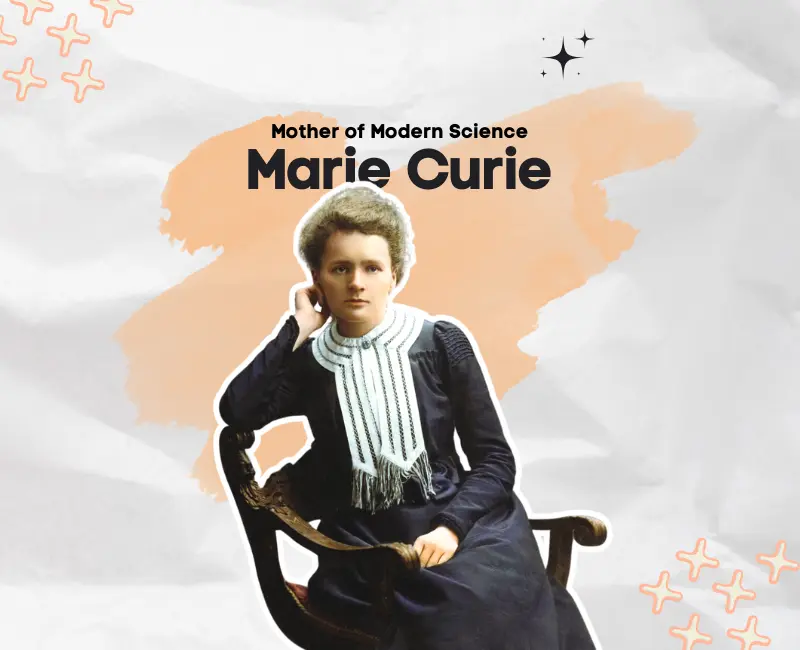Mother of Modern Science: Marie Curie

At a time when the scientific world was dominated by men, the glass of prejudice and stereotype was shattered by a woman. She was more than just a scientist; Madam Marie Curie was a trailblazer whose legacy continues to illuminate the path for aspiring minds across the globe. She was the first woman to win a Nobel Prize and later becomes the only person to win in two different scientific fields, truly her life story is a testament to the power of relentless curiosity and resilience. Her story remains a wake-up call to all brilliant minds, reminding us that science transcends gender.
Her Humble Beginning
Early life
Marie Curie, née Maria Sklodowska, was born in Warsaw, in Congress Poland in the Russian Empire, on 7 November 1867, in a humble household deeply rooted in education. Her father, Władysław Skłodowski, a physics and mathematics teacher, ignited her love for science, while her mother, Bronisława, née Boguska, a school principal, instilled discipline and resilience in young Marie. She was the fifth and youngest child of the couple. The elder siblings of Maria (nicknamed Mania) were Zofia (born 1862, nicknamed Zosia), Józef (born 1863, nicknamed Józio), Bronisława (born 1865, nicknamed Bronia) and Helena (born 1866, nicknamed Hela). Tragedy struck early in her life when she lost her mother to tuberculosis and her eldest sister to typhus, leaving her with a profound sense of determination.
Marie’s childhood was marked by early adversity. Her family faced financial difficulties after her father lost his teaching position due to political unrest. Even more devastating was the loss of her eldest sister, Zofia, to typhus, followed closely by her mother’s death from tuberculosis. These tragedies deeply affected young Marie, fueling her resolve to honor their memory through achievement. Despite her grief, she excelled academically, demonstrating an insatiable curiosity and an exceptional memory that set her apart from her peers.
Marie’s early education was shaped by her father’s encouragement and her own determination. Though barred from formal higher education due to her gender, she sought knowledge through informal means, including attendance at the clandestine Flying University, which secretly provided instruction to women. Her early life experiences—the struggle for education, familial losses, and political turmoil—shaped her character, instilling resilience, independence, and an enduring passion for discovery. These qualities would later define her pioneering journey in science and her unwavering commitment to advancing human knowledge.
Her Diligent Pursue for Higher Education
Marie Curie’s journey to higher education was one of resilience and determination in the face of systemic barriers. Studying in a University was out of question for women in Russian-occupied Poland even if they were academically bright. Marie, however, did not lose hope and looked for other ways of attaining knowledge. To pursue education she joined flying University, which was an underground schooling for women who could not attend formal institutions. This clandestine effort to defy restrictions laid the foundation for her future academic pursuits.
Since Marie understood that she would never get a good financial background to support her ambitions, she made a deal with her sister Bronislawa. Marie became a governess and began earning her income while Bronisława went to the medical school in Paris on condition that once her sister would help her fulfill her educational goals. For a few years, Marie got occupied with several jobs balancing between the responsibilities and guarding her passion for science. At the same time, she received hands-on training in a chemistry laboratory in Warsaw owned by her cousin Józef Boguski who was once a right-hand man to Dmitri Mendeleev. This experience enabled her to develop her expertise as well as provided her with the foundation and desire to advance her education.
Finally, in 1891, Marie’s hard work was rewarded when she moved to Paris to attend the Sorbonne. Focusing on the intense academic setting, she enrolled in physics, chemistry, and mathematics courses. Life in Paris was hardly a happy one; she struggled to make ends meet; she was a poor woman, barely managing to make a living. Yet, her unwavering focus and extraordinary talent helped her excel. By 1893, she had earned a degree in physics, graduating at the top of her class, followed by a second degree in mathematics the following year. For Marie, this period became the period of transition from youthful woman from Warsaw to the scientific genius who would redefine what was possible to know. Years of studies at the Sorbonne paved her scientific career and determined the discovery of phenomena that she was to discover in the years to come.
Her Love Life
Marie Curie’s love life began with a bittersweet chapter during her early years as a governess for the Żorawski family. While working in Szczuki, she fell in love with Kazimierz Żorawski, the son of her employers and a promising mathematician. While their love for each other was strong, Kazimierz’s parents strongly disapproved of the relationship, they were against the idea of their son marrying a penniless relative. The separation was a significant emotional loss for both Marie and Kazimierz. Still, they went on to achieve prominence in their field, eventually Kazimierz became a professor and rector of Kraków University.
In Paris, she met Pierre Curie, a physicist whose brilliance matched her own. When they met Pierre was an instructor at The City of Paris Industrial Physics and Chemistry Higher Educational Institution (ESPCI Paris). Their shared passion for science blossomed into love, and they married in 1895. Pierre became not only her life partner but also her research collaborator. She gained her Doctor of Science degree in 1903 but was soon followed by a heartbreaking event where she lost her partner Pierre to an accident. Despite her profound grief, she took over Pierre’s academic position at the University of Paris, becoming the institution’s first female professor. She was also appointed Director of the Curie Laboratory in the Radium Institute of the University of Paris, founded in 1914.
The Beginning of Discovery: A Journey to New Research
After moving to Paris in 1981 for further studies, Marie struggled but never thought to quit studying. Her aim to achieve greater knowledge led her to live a life overcoming societal obstacles and personal struggles. Despite facing financial hardship, she graduated at the top of her class, earning degrees in physics, chemistry, and mathematics.
Her career peaked when she met Pierre, he was well-known in the scientific community for his work on magnetism. Pierre was struck by Marie’s intellect and passion for science and advised her to pursue a PhD. For many years they worked together before they finally married. Her deep interest in the work of Henri Becquerel, who had discovered the phenomenon of radioactivity, inspired her to study the mysterious rays emitted by uranium. In 1897, she began her own research in this field, dedicating countless hours to the study of uranium’s radioactive properties. In 1898, she made her first major discovery: the element polonium, named after her homeland of Poland.
While Pierre concentrated on studying the physical properties of these radiations, Marie focused on isolating radium in its pure metallic state. With the assistance of André-Louis Debierne, she achieved this challenging feat, earning her a doctorate in science in 1903. That same year, the Curies were jointly awarded the Nobel Prize in Physics alongside Becquerel for their contributions to the understanding of radioactivity.
Death of Pierre and Second Nobel Prize
The untimely death of Pierre Curie on April 19, 1906, in a tragic accident was a profound loss for Marie Curie. Instead of succumbing to the grief she channeled her strength to fulfill the research they had begun together. On May 13, 1906, Marie achieved a historic milestone by being appointed to the professorship left vacant by Pierre’s death, becoming the first woman to teach at the prestigious Sorbonne. By 1908, she had been named a titular professor. Her groundbreaking work culminated in the publication of her seminal treatise on radioactivity in 1910.
Marie’s devotion to her research and tireless work earned her a second Nobel Prize. In 1911, she got the Nobel prize in Chemistry, for isolating pure radium. This achievement left a mark in the scientific community and reinforced her reputation as a pioneering scientist. In 1914, her effort came true as she established the Radium Institute, which would go on to become a hub for nuclear physics and chemistry.
When World War I struck, Marie, with her daughter Irène worked tirelessly contributing to development of mobile X-ray units to battlefield medicine, they are known as petites Curies that assist wounded soldiers. The Radium Institute by Marie began to flourish by 1918, they started full-scale research in radioactive substances and their medical applications. As a member of the Academy of Medicine from 1922, Marie devoted her later years to studying the therapeutic potential of radiation, leaving an enduring legacy of scientific and humanitarian achievements.
Award and Accolades
Nobel Prize
- 1903 – Nobel Prize in Physics
The first Nobel prize was awarded jointly to Marie Curie, Pierre Curie, and Henri Becquerel for their combined work on radioactivity. She was the first woman to receive a Nobel Prize and became an icon for all the women.
- 1911 – Nobel Prize in Chemistry
She was bestowed with Nobel prize for her discovery of the elements polonium and radium, and for her work on the isolation and study of radium. She became the first person to win Nobel Prizes in two different scientific fields.
Other Major Awards and Honors
- Davy Medal (1903)
Marie and Pierre Curie both were awarded by the Royal Society for their contributions to the study of radioactivity.
- Matteucci Medal (1904)
She was bestowed by the Italian Society of Sciences for her exceptional work in physics.
- Elliott Cresson Medal (1909)
This award was presented by the Franklin Institute in the United States for her outstanding scientific achievements.
- Willard Gibbs Award (1921)
The American Chemical Society granted this award in recognition of her significant contributions to chemistry.
- Grand Prix du Marquis d’Argenteuil (1926)
She was awarded by the Belgian Academy for her exceptional contributions to science.
Honors and Appointments
- Membership in the Academy of Medicine (1922) for her efforts to apply radioactive substances in medical treatments.
- Honorary Doctorates: Marie Curie received numerous honorary doctorates from prestigious universities worldwide, including the University of Paris and the University of Geneva.
- Panthéon Enshrinement (1995): In recognition of her contributions, her ashes were interred in the Panthéon in Paris, making her the first woman honored for her achievements.
Marie Curie’s legacy is also immortalized in the naming of the element curium, and she continues to inspire generations with her unparalleled dedication to science.
Conclusion
Marie Curie’s life and achievements remain a testament for all the women as well scientist, who are dedicating their whole life to achieve something and working towards the betterment of society. Her humble beginning taught us that dreams do come true with hard work and dedication. Her true resilience and determinations show how she valued education over everything, breaking societal barriers and financial conditions, she carved a path for women in science. Her pioneering work on radioactivity not only earned her two Nobel Prizes but laid a foundation for modern nuclear physics, medical treatment and for many upcoming research, discoveries and innovations in various fields.
Beyond her scientific contributions, Marie Curie’s relentless pursuit of knowledge and her dedication to humanity’s progress is an inspiration. Her legacy lives on through her discoveries, the institutions she helped establish, and the generations of scientists she influenced. Truly she is the “Mother of Modern Science”!


